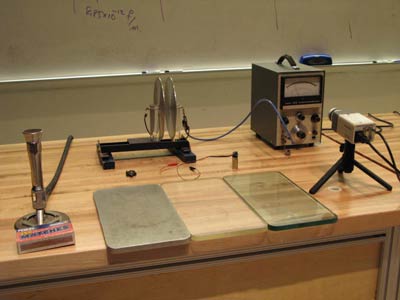Dielectric and Capacitor 5C20.10

The separable parallel-plate capacitor, the battery, and the dielectric plates are in the Electrostatics Cabinet, A4.
The Electrometer is in the Electrostatics Cabinet, B1.
The bunsen burner is in the Thermodynamics Cabinet, ??.
If lecturing to a large class, project a camera view of the electrometer on a screen.
Insertion of dielectric slabs changes the capacitance, and hence the voltage, of a fixed-charge capactior.
Note: it is very difficult to do this if one is wearing clothing of silk or wool, or certain types of synthetic fabric, because these hold charge very well. In addition, one may have to keep one's body still, and not shuffle one's feel on the floor, to demonstrate the effect.
Connect the parallel-plate capacitor to the electrometer, set the plates 3 cm apart, and charge it to 9V using the battery.
Note: the closer the plates, the more obvious the effect; however, the greater the dexterity required to insert the dielectric slabs without touching the plates.
Light the bunsen burner.
Repeat this process for each dielectric slab:
- pass the slab quickly through the flame (about 10 cm above the burner) so the hot air flow removes the surface charge.
- bring the slab close to the plates but do not insert it. The electrometer needle should not deflect. If the electrometer needle deflects, the slab is still charged. Continue passing the dielectric quickly through the flame, making sure that edges and corners pass through the flame.
- once you can bring the slab close to the plates without affecting the needle, insert the slab between the plates. Do not touch the plates with the slab. The needle should relax towards zero.
- remove the slab. The needle should return to its previous value.
Note: if your hands are not charged, placing a hand in between the plates (without touching them) will also cause the needle to relax, indicating that the effective dielectric constant of your hand is greater than one.
The metal slab should have the greatest effect, the plastic slab the least, glass in the middle.
Discussion: The dielectric constant of the glass is greater than the plastic. The metal has an effectively infinite dielectric constant. Since Q=CV is a constant, it takes work to remove the dielectric from between the plates.
Note: the metal must be passed through the plate to fully discharge it because its surface is not clean, and may therefore hold a charge.